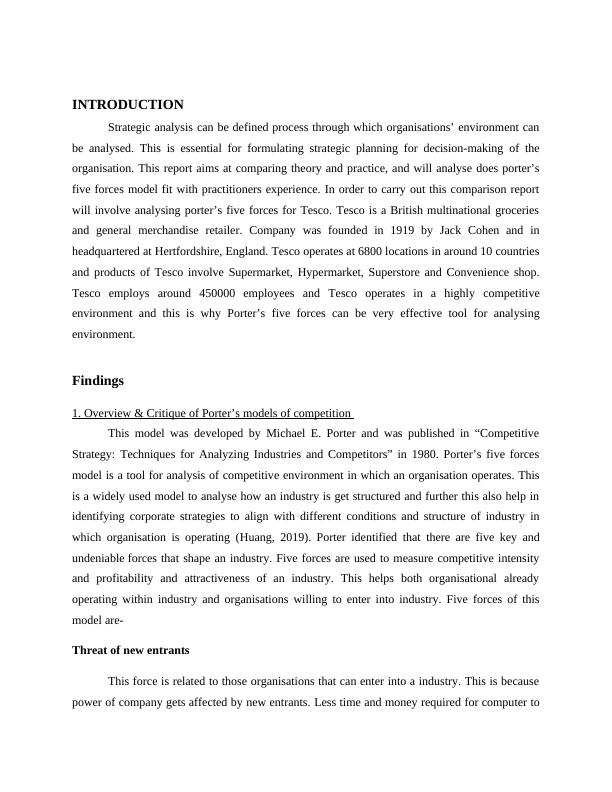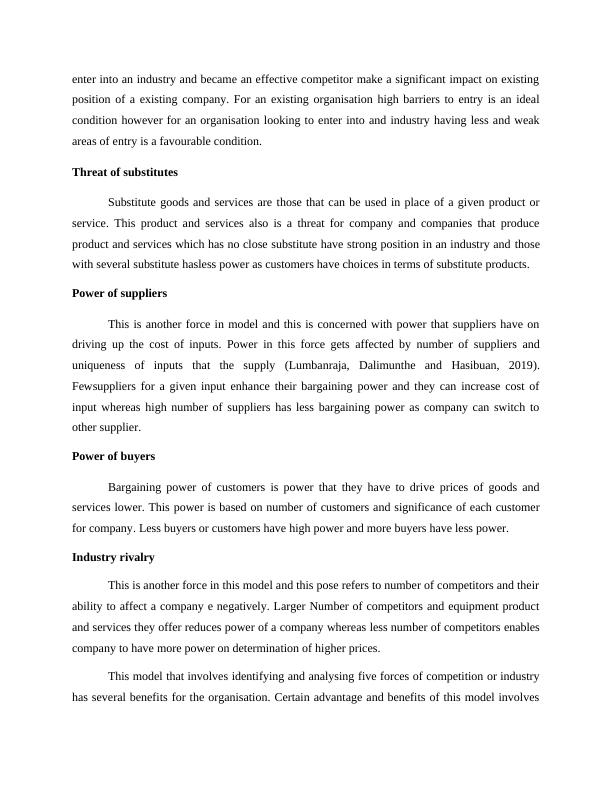Strategic Management: Analysis of Porter's Five Forces Model for Tesco
Added on 2023-01-05
12 Pages3890 Words97 Views
Strategic Management

Table of Contents
INTRODUCTION...........................................................................................................................3
Findings...........................................................................................................................................3
1. Overview & Critique of Porter’s models of competition........................................................3
2. Company analysis....................................................................................................................5
3. Does this theory and practice work?........................................................................................7
CONCLUSION..............................................................................................................................10
Recommendation...........................................................................................................................10
REFERENCES..............................................................................................................................11
INTRODUCTION...........................................................................................................................3
Findings...........................................................................................................................................3
1. Overview & Critique of Porter’s models of competition........................................................3
2. Company analysis....................................................................................................................5
3. Does this theory and practice work?........................................................................................7
CONCLUSION..............................................................................................................................10
Recommendation...........................................................................................................................10
REFERENCES..............................................................................................................................11

INTRODUCTION
Strategic analysis can be defined process through which organisations’ environment can
be analysed. This is essential for formulating strategic planning for decision-making of the
organisation. This report aims at comparing theory and practice, and will analyse does porter’s
five forces model fit with practitioners experience. In order to carry out this comparison report
will involve analysing porter’s five forces for Tesco. Tesco is a British multinational groceries
and general merchandise retailer. Company was founded in 1919 by Jack Cohen and in
headquartered at Hertfordshire, England. Tesco operates at 6800 locations in around 10 countries
and products of Tesco involve Supermarket, Hypermarket, Superstore and Convenience shop.
Tesco employs around 450000 employees and Tesco operates in a highly competitive
environment and this is why Porter’s five forces can be very effective tool for analysing
environment.
Findings
1. Overview & Critique of Porter’s models of competition
This model was developed by Michael E. Porter and was published in “Competitive
Strategy: Techniques for Analyzing Industries and Competitors” in 1980. Porter’s five forces
model is a tool for analysis of competitive environment in which an organisation operates. This
is a widely used model to analyse how an industry is get structured and further this also help in
identifying corporate strategies to align with different conditions and structure of industry in
which organisation is operating (Huang, 2019). Porter identified that there are five key and
undeniable forces that shape an industry. Five forces are used to measure competitive intensity
and profitability and attractiveness of an industry. This helps both organisational already
operating within industry and organisations willing to enter into industry. Five forces of this
model are-
Threat of new entrants
This force is related to those organisations that can enter into a industry. This is because
power of company gets affected by new entrants. Less time and money required for computer to
Strategic analysis can be defined process through which organisations’ environment can
be analysed. This is essential for formulating strategic planning for decision-making of the
organisation. This report aims at comparing theory and practice, and will analyse does porter’s
five forces model fit with practitioners experience. In order to carry out this comparison report
will involve analysing porter’s five forces for Tesco. Tesco is a British multinational groceries
and general merchandise retailer. Company was founded in 1919 by Jack Cohen and in
headquartered at Hertfordshire, England. Tesco operates at 6800 locations in around 10 countries
and products of Tesco involve Supermarket, Hypermarket, Superstore and Convenience shop.
Tesco employs around 450000 employees and Tesco operates in a highly competitive
environment and this is why Porter’s five forces can be very effective tool for analysing
environment.
Findings
1. Overview & Critique of Porter’s models of competition
This model was developed by Michael E. Porter and was published in “Competitive
Strategy: Techniques for Analyzing Industries and Competitors” in 1980. Porter’s five forces
model is a tool for analysis of competitive environment in which an organisation operates. This
is a widely used model to analyse how an industry is get structured and further this also help in
identifying corporate strategies to align with different conditions and structure of industry in
which organisation is operating (Huang, 2019). Porter identified that there are five key and
undeniable forces that shape an industry. Five forces are used to measure competitive intensity
and profitability and attractiveness of an industry. This helps both organisational already
operating within industry and organisations willing to enter into industry. Five forces of this
model are-
Threat of new entrants
This force is related to those organisations that can enter into a industry. This is because
power of company gets affected by new entrants. Less time and money required for computer to

enter into an industry and became an effective competitor make a significant impact on existing
position of a existing company. For an existing organisation high barriers to entry is an ideal
condition however for an organisation looking to enter into and industry having less and weak
areas of entry is a favourable condition.
Threat of substitutes
Substitute goods and services are those that can be used in place of a given product or
service. This product and services also is a threat for company and companies that produce
product and services which has no close substitute have strong position in an industry and those
with several substitute hasless power as customers have choices in terms of substitute products.
Power of suppliers
This is another force in model and this is concerned with power that suppliers have on
driving up the cost of inputs. Power in this force gets affected by number of suppliers and
uniqueness of inputs that the supply (Lumbanraja, Dalimunthe and Hasibuan, 2019).
Fewsuppliers for a given input enhance their bargaining power and they can increase cost of
input whereas high number of suppliers has less bargaining power as company can switch to
other supplier.
Power of buyers
Bargaining power of customers is power that they have to drive prices of goods and
services lower. This power is based on number of customers and significance of each customer
for company. Less buyers or customers have high power and more buyers have less power.
Industry rivalry
This is another force in this model and this pose refers to number of competitors and their
ability to affect a company e negatively. Larger Number of competitors and equipment product
and services they offer reduces power of a company whereas less number of competitors enables
company to have more power on determination of higher prices.
This model that involves identifying and analysing five forces of competition or industry
has several benefits for the organisation. Certain advantage and benefits of this model involves
position of a existing company. For an existing organisation high barriers to entry is an ideal
condition however for an organisation looking to enter into and industry having less and weak
areas of entry is a favourable condition.
Threat of substitutes
Substitute goods and services are those that can be used in place of a given product or
service. This product and services also is a threat for company and companies that produce
product and services which has no close substitute have strong position in an industry and those
with several substitute hasless power as customers have choices in terms of substitute products.
Power of suppliers
This is another force in model and this is concerned with power that suppliers have on
driving up the cost of inputs. Power in this force gets affected by number of suppliers and
uniqueness of inputs that the supply (Lumbanraja, Dalimunthe and Hasibuan, 2019).
Fewsuppliers for a given input enhance their bargaining power and they can increase cost of
input whereas high number of suppliers has less bargaining power as company can switch to
other supplier.
Power of buyers
Bargaining power of customers is power that they have to drive prices of goods and
services lower. This power is based on number of customers and significance of each customer
for company. Less buyers or customers have high power and more buyers have less power.
Industry rivalry
This is another force in this model and this pose refers to number of competitors and their
ability to affect a company e negatively. Larger Number of competitors and equipment product
and services they offer reduces power of a company whereas less number of competitors enables
company to have more power on determination of higher prices.
This model that involves identifying and analysing five forces of competition or industry
has several benefits for the organisation. Certain advantage and benefits of this model involves

End of preview
Want to access all the pages? Upload your documents or become a member.
Related Documents
Application of Porter’s Five Forces modellg...
|12
|698
|271
Strategic Models: Porter’s Five Forces, Ansoff Matrix, VRIN, SWOT Analysislg...
|12
|1469
|54
SEAT 'Minimo' in Melbournelg...
|9
|3919
|62
Critical Analysis of Industry Practices in Strategic Hospitality Managementlg...
|14
|3757
|282
Impact of TESCO on Competitive Forceslg...
|2
|755
|238
Porter's Five Forces Model - MHN123208 - Business Strategylg...
|7
|1280
|973